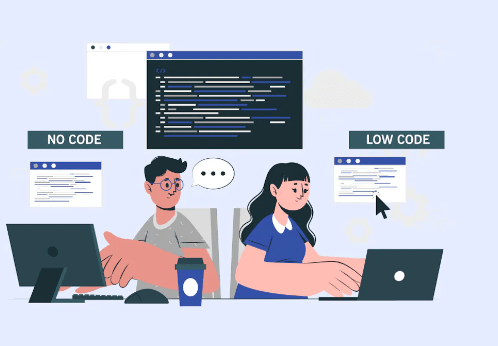Introduction to No-Code Development: What It Is and Why It Matters

The field of software development is changing thanks to no-code development. It marks a paradigm shift in the creation of applications, making it possible for anyone with little to no programming skills to produce useful software. The term no-code development describes the use of platforms that, as an alternative to conventional programming, let people create programs using graphical user interfaces and setups. No-code development services offer a drag-and-drop interface and pre-made templates to enable the creation of software applications without the need to write code.
No-code is not a novel idea. It was first introduced in the 1990s with the release of Visual Basic and other early visual programming languages. However, the modern iteration of no-code tools has evolved predominantly, driven by the need for rapid digital transformation and the democratization of technology. Today’s no-code platforms are more sophisticated, offering a large number of functionalities that can minimize coding in terms of complexity and performance.
In an era where digital transformation is a top priority for manyorganizations, no-code development plays an important role. It speeds up the development process, reduces prices, and empowers a broader range of people to contribute to software development. This is particularly important as the Demand for software outpaces the supply of professional developers.
What is No-Code Development?
No-code development platforms are designed to streamline the software creation process, making it accessible to non-developers. Here is an in-depth look at what these platforms entail.
Key Features of No-Code Platforms
- Visual Improvement Interfaces
No-code platforms use visual interfaces that allow users to design applications through a graphical interface. Users can drag and drop elements to create user interfaces and workflows.
- Drag-and-Drop Functionality
This feature simplifies the process of adding components, such as buttons, forms, and data fields, by allowing users to drag and drop these elements into place.
- Pre-built Templates and Components
Many no-code platforms offer a library of templates and components that users can leverage to quickly build applications. These templates are customizable, enabling users to tailor them to their specific needs.
Common Features of No-Code Tools
- Workflow Automation
No-code platforms often include tools for automating business processes, such as approvals, notifications, and data updates, without needing to write code.
- Integration Capabilities
Integration with other software systems and services is a key feature. No-code platforms typically offer pre-built connectors for popular services like Google Workspace, Salesforce, and various APIs.
- User-Friendly Design
These platforms are designed with usability in mind, featuring in-built interfaces that guide users through the application-building process.
Popular No-Code Platforms
There are several foremost no-code platforms, each with unique features and capabilities. Understanding these platforms helps in choosing the right one for specific needs. Leading No-Code Platforms are:
Bubble
Known for its robust features and flexibility, Bubble allows users to create complex applications, including web and mobile apps.
Adalo
Adalo specializes in mobile app development, providing tools to create fully functional mobile applications with ease.
Webflow
Webflow is geared towards web designers, enabling them to build responsive websites visually while maintaining complete design control.
Airtable
Airtable combines the functionalities of a spreadsheet with a database, making it ideal for establishing data and building applications that depend heavily on data manipulation.
Comparative Analysis of Popular No-Code Platforms
Strengths and Weaknesses
Bubble offers wide customization options but has a steeper learning curve compared to additional platforms. Adalo shines in ease of use for mobile app creation but may lack some progressive features needed for more complex applications. Webflow provides powerful web design tools but is more suited for design-focused projects rather than full-scale applications. Airtable is incredibly user-friendly and great for data-centric applications but might require additional integrations for complex workflows.
Use Cases for Different Platforms
- Bubble is suitable for creating complete web applications.
- Adalo is ideal for startups and entrepreneurs looking to lift of mobile apps quickly.
- Webflow is best for web creators and activities focusing on creating high-quality websites.
- Airtable is perfect for squads needing to manage data and workflows professionally.
Benefits of No-Code Development
- No-code development offers many advantages, making it a valuable tool in various contexts.
- Accessibility and Democratization of Software Development
- Empowering Non-Technical Users
- No-code platforms empower individuals without technical
- backgrounds to create software, fostering innovation and creativity across different fields.
- Reducing Dependency on Developers
- Organizations can reduce their reliance on scarce developer resources, allowing technical teams to focus on more complex and critical tasks.
- Speed and Efficiency
- Faster Prototyping and Deployment
- No-code development significantly accelerates the prototyping phase, enabling quicker iterations and faster time-to-market.
- Cost-Effectiveness
- By reducing the need for specialized coding skills and shortening development timelines and no-code platforms can lower development costs.
- Flexibility and Adaptability
- Relaxed Iterations and Bring up-to-date
- Applications built on no-code platforms can be easily updated and iterated upon, allowing for constant improvement and edition to changing
- requirements.
- Scaling Competences
- Many no-code platforms support scalable substructure, enabling app to grow alongside the business without extensive redevelopment.
Challenges and Limitations
While no-code development offers many benefits, it is not without its challenges and limitations.
Scalability Apprehensions
No-code platforms may struggle with scalability for highly multifaceted or data-intensive applications, potentially leading to performance blockages.
Performance Subjects
Applications built on no-code platforms might face performance issues due to the abstraction layers used, which can be less efficient than custom-coded solutions.
Security and Compliance Dangers
No-code platforms might not offer the same level of safety and amenability features as traditional development environments, posing risks for sensitive applications.
Partial Customization Choices
While no-code platforms are elastic, they might not provide the level of customization required for highly specialized submissions, demanding some level of traditional coding.
No-Code Development Use Cases
No-code development is multipurpose and can be applied in various contexts, each benefiting differently from the approach.
Small Businesses and Startups
No-code platforms allow small businesses and startups to quickly launch applications, streamline operations, and contest with larger companies by reducing development time and prices.
Inner Tools and Business Process Automation
Organizations can use no-code tools to develop internal applications that automate business processes, educate efficiency and reducing labor-intensive workloads.
Prototyping and MVP Development
Businesspersons and modernizers can leverage no-code platforms to build and test minimum viable products (MVPs) fast, validating ideas before capitalizing in full-scale development.
Scholastic and Non-Profit Organizations
Educational institutions and nonprofits can use no-code tools to create applications custom-made to their exclusive needs without requiring noteworthy
The Future of No-Code Development
The future of no-code development looks promising, with several trends and innovations on the horizon.
Trends and Innovations
Integration with AI and Machine Learning
No-code platforms are increasingly incorporating AI and machine learning capabilities, allowing users to incorporate advanced functionalities into their applications without deep practical knowledge.
Expansion of No-Code Ecosystems
The ecologies around no-code platforms are expanding, with more plugins, integrations, and community-driven resources becoming available, further enhancing their competencies.
Potential Impact on the Job Market
New Title Role and Chances
The increase in no-code development is creating new roles, such as citizen developers, who use no-code tools to solve business problems without an old-fashioned software development background.
Shifting Talent Requirements
As no-code tools become more prevalent, the talent requirements in
The job market is shifting. There is a growing need for individuals who comprehend both business processes and how to leverage no-code platforms effectively.
Conclusion
No-code development has transformed the software industry by making app and software creation accessible to those without traditional coding skills. No code development by Hashlogics has witnessed its evolution from early visual programming environments to today’s advanced platforms, characterized by visual interfaces, drag-and-drop functionality, and pre-built templates. Leading no-code platforms like Bubble, Adalo, Webflow, and Airtable each offer unique strengths and use cases. The benefits of no-code development include accessibility, speed, cost-effectiveness, and flexibility, while challenges include scalability, performance, security, and customization limitations. We have explored various use cases and future trends, highlighting their potential impact on the job market and integration with AI and machine learning.
No-code development represents a significant shift in software creation, democratizing access and enabling broader contributions in the digital space. It hastens the digital revolution, allowing businesses to quickly develop and iterate on applications, thus improving operations and customer experiences. At Hashlogics, we recognize that no-code tools also help bridge the tech services gap, empowering non-developers and fostering cross-functional partnerships within organizations.
To connect with the potential of no-code tools, start by identifying your development needs and exploring various platforms that suit those requirements. Many platforms offer free trials and learning resources like tutorials and forums. Begin with small projects to gain experience, and engage with online communities for support and inspiration. Stay informed about industry trends by following news, attending webinars, and participating in conferences.
No-code development is more than a trend; it represents a fundamental change in how we approach software creation. By embracing no-code tools with Hashlogics, we can achieve new levels of innovation, efficiency, and inclusivity. Now is the time to discover these tools and become part of the no-code uprising. The future of software development is here, and with Hashlogics, it is accessible to everyone.





